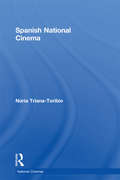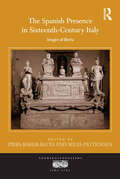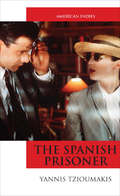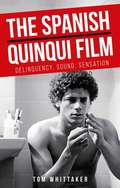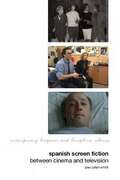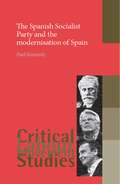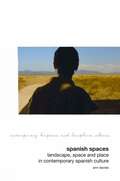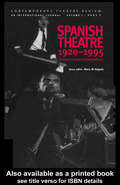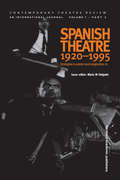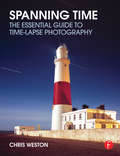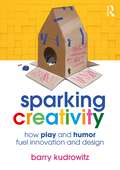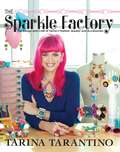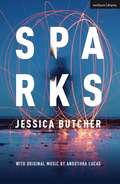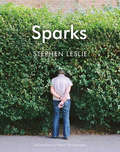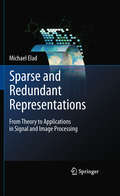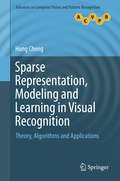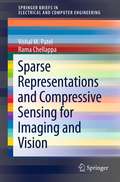- Table View
- List View
Spanish National Cinema (National Cinemas)
by Nuria Triana-ToribioThis study examines the discourses of nationalism as they intersected or clashed with Spanish film production from its inception to the present. While the book addresses the discourses around filmmakers such as Almodóvar and Medem, whose work has achieved international recognition, Spanish National Cinema is particularly novel in its treatment of a whole range of popular cinema rarely touched on in studies of Spanish cinema. Using accounts of films, popular film magazines and documents not readily available to an English-speaking audience, as well as case studies focusing on the key issues of each epoch, this volume illuminates the complex and changing relationship between cinema and Spanish national identity.
The Spanish Presence in Sixteenth-Century Italy: Images of Iberia (Transculturalisms, 1400-1700)
by Piers Baker-Bates Miles PattendenThe sixteenth century was a critical period both for Spain’s formation and for the imperial dominance of her Crown. Spanish monarchs ruled far and wide, spreading agents and culture across Europe and the wider world. Yet in Italy they encountered another culture whose achievements were even prouder and whose aspirations often even grander than their own. Italians, the nominally subaltern group, did not readily accept Spanish dominance and exercised considerable agency over how imperial Spanish identity developed within their borders. In the end Italians’ views sometimes even shaped how their Spanish colonizers eventually came to see themselves. The essays collected here evaluate the broad range of contexts in which Spaniards were present in early modern Italy. They consider diplomacy, sanctity, art, politics and even popular verse. Each essay excavates how Italians who came into contact with the Spanish crown’s power perceived and interacted with the wider range of identities brought amongst them by its servants and subjects. Together they demonstrate what influenced and what determined Italians’ responses to Spain; they show Spanish Italy in its full transcultural glory and how its inhabitants projected its culture - throughout the sixteenth century and beyond.
The Spanish Presence in Sixteenth-Century Italy: Images of Iberia (Transculturalisms, 1400-1700)
by Piers Baker-Bates Miles PattendenThe sixteenth century was a critical period both for Spain’s formation and for the imperial dominance of her Crown. Spanish monarchs ruled far and wide, spreading agents and culture across Europe and the wider world. Yet in Italy they encountered another culture whose achievements were even prouder and whose aspirations often even grander than their own. Italians, the nominally subaltern group, did not readily accept Spanish dominance and exercised considerable agency over how imperial Spanish identity developed within their borders. In the end Italians’ views sometimes even shaped how their Spanish colonizers eventually came to see themselves. The essays collected here evaluate the broad range of contexts in which Spaniards were present in early modern Italy. They consider diplomacy, sanctity, art, politics and even popular verse. Each essay excavates how Italians who came into contact with the Spanish crown’s power perceived and interacted with the wider range of identities brought amongst them by its servants and subjects. Together they demonstrate what influenced and what determined Italians’ responses to Spain; they show Spanish Italy in its full transcultural glory and how its inhabitants projected its culture - throughout the sixteenth century and beyond.
The Spanish Prisoner (American Indies)
by Yannis TzioumakisDespite more than a passing nod to such crowdpleasing classics as Hitchcock's North by Northwest, playwright-turned-independent filmmaker David Mamet's The Spanish Prisoner is a particularly idiosyncratic film that betrays its origin outside the Hollywood mainstream. Featuring a convoluted narrative, an excessive, often anti-classical, visual style, and belonging to the generic category of the'con game film' which often challenges the spectator's cognitive skills, The Spanish Prisoner is a film that bridges genre filmmaking withpersonal visual style, independent film production with niche distribution,and mainstream subject matter with unconventional filmic techniques.This book discusses The Spanish Prisoner as an example of contemporary American independent cinema while also using the film as a vehicle to explore several key ideas in film studies, especially in terms of aesthetics, narrative, style, spectatorship, genre and industry.Key FeaturesoDistinguishes between independent and 'indie' cinema through anexamination of the 'classics divisions,' especially Sony Pictures ClassicsoAssesses the position of David Mamet within American cinemaoIntroduces the genre categories of the 'con artist' and the 'con game' filmand discusses The Spanish Prisoner as a key example of the latteroExamines the ways in which narrative, narration and visual style deviatefrom the mainstream/classical aesthetic
The Spanish quinqui film: Delinquency, sound, sensation (Manchester University Press)
by Tom WhittakerThis is the first major study in English of cine quinqui, a cycle of popular Spanish films from the late 1970s and early 1980s that starred real-life juvenile delinquents. The book provides a close analysis of key quinqui films by directors such as Eloy de la Iglesia, José Antonio de la Loma and Carlos, as well as the moral panics, public fears and media debates that surrounded their controversial production and reception. In paying particular attention to the soundtrack of the films, the book shows how marginal youth cultures during Spain’s transition to democracy were shaped by sound. It will be of interest to scholars and students of Spanish film, history and cultural studies, and those working in sound studies and youth subcultures more broadly.
The Spanish quinqui film: Delinquency, sound, sensation (Manchester University Press)
by Tom WhittakerThis is the first major study in English of cine quinqui, a cycle of popular Spanish films from the late 1970s and early 1980s that starred real-life juvenile delinquents. The book provides a close analysis of key quinqui films by directors such as Eloy de la Iglesia, José Antonio de la Loma and Carlos, as well as the moral panics, public fears and media debates that surrounded their controversial production and reception. In paying particular attention to the soundtrack of the films, the book shows how marginal youth cultures during Spain’s transition to democracy were shaped by sound. It will be of interest to scholars and students of Spanish film, history and cultural studies, and those working in sound studies and youth subcultures more broadly.
Spanish Screen Fiction: Between Cinema and Television (Contemporary Hispanic and Lusophone Cultures #3)
by Paul SmithThis pioneering book is the first to argue that cinema and television in Spain only make sense when considered together as twin vehicles for screen fiction. The Spanish audiovisual sector is now one of the most successful in the world, with feature films achieving wider distribution in foreign markets than nations with better known cinematic traditions and newly innovative TV formats, already dominant at home, now widely exported. Beyond the industrial context, which has seen close convergence of the two media, this book also examines the textual evidence for crossover between cinema and television at the level of narrative and form. The book, which is of interest to both Hispanic and media studies, gives new readings of some well-known texts and discovers new or forgotten ones. For example it compares Almodóvar’s classic feature Mujeres al borde de un ataque de nervios (‘Women on the Verge of a Nervous Breakdown’) with his production company El Deseo’s first venture into TV production, the 2006 series also known as Mujeres (‘Women’). It also reclaims the lost history of female flat share comedy on Spanish TV from the 1960s to the present day. It examines a wide range of prize winning workplace drama on TV, from police shows, to hospital and legal series. Amenábar’s Mar adentro (‘The Sea Inside’) an Oscar-winning film on the theme of euthanasia, is contrasted with its antecedent, an episode of national network Tele5’s top-rated drama Periodistas. The book also traces the attempt to establish a Latin American genre, the telenovela, in the very different context of Spanish scheduling. Finally it proposes two new terms: ‘Auteur TV’ charts the careers of creators who have established distinctive profiles in television over decades; ‘sitcom cinema’ charts, conversely, the incursion of television aesthetics and economics into the film comedies that have proved amongst the most popular features at the Spanish box office in the last decade.
The Spanish Socialist Party and the modernisation of Spain (Critical Labour Movement Studies)
by Paul KennedyThis book considers the most electorally successful political party in Spain, the Spanish Socialist Workers’ Party (PSOE), which was in government for two of the three decades since it won office under Felipe González in 1982. Providing rich historical background, the book’s main focus is on the period since General Franco’s death in 1975. It charts Spain’s modernisation under the PSOE, with a particular focus on the role played by European integration in this process. Covering events including the 2011 general election, the book is one of the most up-to-date works available in English and will be of great interest to academics and undergraduate and postgraduate students in the field of Spanish and European studies.
The Spanish Socialist Party and the modernisation of Spain (Critical Labour Movement Studies)
by Paul KennedyThis book considers the most electorally successful political party in Spain, the Spanish Socialist Workers’ Party (PSOE), which was in government for two of the three decades since it won office under Felipe González in 1982. Providing rich historical background, the book’s main focus is on the period since General Franco’s death in 1975. It charts Spain’s modernisation under the PSOE, with a particular focus on the role played by European integration in this process. Covering events including the 2011 general election, the book is one of the most up-to-date works available in English and will be of great interest to academics and undergraduate and postgraduate students in the field of Spanish and European studies.
Spanish Spaces: Landscape, Space and Place in Contemporary Spanish Culture (Contemporary Hispanic and Lusophone Cultures #6)
by Ann DaviesAn Open Access edition of this book is available on the Liverpool University Press website and the OAPEN library.Spanish Spaces is a pioneering study that marries contemporary cultural geography with contemporary Spanish culture. The field of cultural geography has grown both extensively and rapidly, as has the field of cultural analysis and debate on Spanish cultural texts; yet despite a convergence in study between cultural geography (and cultural studies more widely) and cultural texts themselves, this has made little impact to date within the area of contemporary Spanish cultural studies. Yet Spain’s varied terrain, with complex negotiations between rural, urban and coastal (negotiations that have on occasion spilled over into political and violent conflict), and perhaps its very lack of a contemporary landscape tradition familiar to British and German cultural studies, offer the opportunity for fresh insights into questions of landscape, space and place. Drawing on case studies from contemporary Spanish film and literature, Davies explores the themes of memory and forgetting, nationalism and terrorism, crime and detection, gender, tourism and immigration, investigating what it means to think of space and places in specifically Spanish terms.
Spanish Theatre 1920-1995: Strategies in Protest and Imagination (1)
by Maria M. DelgadoBeginning with a reassessment of the 1920s and 30s, this text looks beyond a consideration of just the most successful Spanish playwrights of the time, and discusses also the work of directors, theorists, actors and designers.
Spanish Theatre 1920-1995: Strategies in Protest and Imagination (1)
by Maria M. DelgadoBeginning with a reassessment of the 1920s and 30s, this text looks beyond a consideration of just the most successful Spanish playwrights of the time, and discusses also the work of directors, theorists, actors and designers.
Spanish Theatre 1920 - 1995: Strategies in Protest and Imagination (2)
by Maria M. DelgadoBeginning with a reassessment of the 1920s and 30s, this text looks beyond a consideration of just the most successful Spanish playwrights of the time, and discusses also the work of directors, theorists, actors and designers.
Spanish Theatre 1920 - 1995: Strategies in Protest and Imagination (2) (Contemporary Theatre Review Ser. #Vols. 7, Pts. 4)
by Maria M DelgadoBeginning with a reassessment of the 1920s and 30s, this text looks beyond a consideration of just the most successful Spanish playwrights of the time, and discusses also the work of directors, theorists, actors and designers.
Spanning Time: The Essential Guide to Time-lapse Photography
by Chris WestonSpanning Time: The Essential Guide to Time-lapse Photography is the ultimate how-to guide for creating time-lapse films, featuring both still and moving image techniques. Author Chris Weston provides all the information necessary to create compelling time-lapse sequences using a DSLR camera. As well as covering basic equipment requirements and shooting techniques, the book explores what makes a good time-lapse story, visualization, and advanced skills for creating multi-faceted time-lapse sequences. This book provides insider secrets including: How to create an effective time-lapse workflow and ‘see’ in a time-lapse sequence Tips and tricks to successful photographic elements such as shutter speed, aperture, exposure, ISO, dynamic range imaging, and more Step-by-step instructions for using the leading photographic processing hardware and software Best practices for overcoming challenges including time-lapse flicker, light conditions, and color temperatures
Spanning Time: The Essential Guide to Time-lapse Photography
by Chris WestonSpanning Time: The Essential Guide to Time-lapse Photography is the ultimate how-to guide for creating time-lapse films, featuring both still and moving image techniques. Author Chris Weston provides all the information necessary to create compelling time-lapse sequences using a DSLR camera. As well as covering basic equipment requirements and shooting techniques, the book explores what makes a good time-lapse story, visualization, and advanced skills for creating multi-faceted time-lapse sequences. This book provides insider secrets including: How to create an effective time-lapse workflow and ‘see’ in a time-lapse sequence Tips and tricks to successful photographic elements such as shutter speed, aperture, exposure, ISO, dynamic range imaging, and more Step-by-step instructions for using the leading photographic processing hardware and software Best practices for overcoming challenges including time-lapse flicker, light conditions, and color temperatures
Sparking Creativity: How Play and Humor Fuel Innovation and Design
by Barry KudrowitzBlending popular culture and design theory, framed by a decade of scholarly research, this book highlights how play and humor fuel innovation. Now, more than ever, we are in need of creative solutions to global problems, but creative skills and abilities decline over time without intervention and practice. Sparking Creativity provides empirically supported methods for embracing the often-trivialized domains of play and humor to increase our creativity. It shows that topical examples, such as Seinfeld's humor, the Apples to Apples board game, and the Adventure Time cartoon series, are more closely related to innovation than you might first think. The book is organized into five main parts, each containing short, engaging subsections and informative, playful, and colorful illustrations to demonstrate concepts. Written in a humorous and accessible style, this book is aimed toward creative-minded entrepreneurs, designers, engineers, industry leaders, parents, educators, and students. It encourages a playful approach throughout a design process to produce truly innovative solutions.
Sparking Creativity: How Play and Humor Fuel Innovation and Design
by Barry KudrowitzBlending popular culture and design theory, framed by a decade of scholarly research, this book highlights how play and humor fuel innovation. Now, more than ever, we are in need of creative solutions to global problems, but creative skills and abilities decline over time without intervention and practice. Sparking Creativity provides empirically supported methods for embracing the often-trivialized domains of play and humor to increase our creativity. It shows that topical examples, such as Seinfeld's humor, the Apples to Apples board game, and the Adventure Time cartoon series, are more closely related to innovation than you might first think. The book is organized into five main parts, each containing short, engaging subsections and informative, playful, and colorful illustrations to demonstrate concepts. Written in a humorous and accessible style, this book is aimed toward creative-minded entrepreneurs, designers, engineers, industry leaders, parents, educators, and students. It encourages a playful approach throughout a design process to produce truly innovative solutions.
The Sparkle Factory: The Design and Craft of Tarina's Fashion Jewelry and Accessories
by Tarina TarantinoTarina Tarantino&’s love affair with fashion jewelry and accessories began when she was just a little girl. Tarina now owns and operates her famous global jewelry, accessories, and cosmetics brand, TARINA TARANTINO, out of her international headquarters in downtown Los Angeles, The Sparkle Factory. In her first book, Tarina invites you into her world to learn how to make and wear beautiful and inspirational fashion jewelry. Fashionistas, aspiring jewelry designers, and DIY lovers will learn how to make 20 of Tarina's most essential pieces including statement earrings, cocktail rings, hair jewelry, stretch cuff bracelets, embellished spectacles, and more. Fans of Tarina will also learn about her brand history, getting inspired, creating themes and stories, sourcing materials, essential tools and techniques, how to wear and style your jewelry wardrobe, and more. The text is complemented by tips and hundreds of full-color photos throughout.
Sparks (Modern Plays)
by Jessica Butcher Anoushka LucasFifteen years of disconnected sparks to do the damage.To stop her beautiful fantastical brain from working.'Fall in love in my early 20s, get married in my late 20s, have at least one child by the time I'm 30. F*ck!'Life is hard to navigate when you've got so many questions. Can I put this jumper in the washing machine? Do you have my birth certificate? Where did you find love? How did you do it? How do you survive? A story of a kamikaze love affair with unexpected consequences. Hilarious and heartbreaking, written by Jessica Butcher and with original music by Anoushka Lucas. Sparks is a two-hander musical about thebrain's response to grief. This edition was published to coincide with the run at the Edinburgh Festival Fringe in August 2018, ahead of its transfer to the HighTide Festivals 2018 in Aldeburgh, Suffolk and Walthamstow, London.
Sparks (Modern Plays)
by Jessica Butcher Anoushka LucasFifteen years of disconnected sparks to do the damage.To stop her beautiful fantastical brain from working.'Fall in love in my early 20s, get married in my late 20s, have at least one child by the time I'm 30. F*ck!'Life is hard to navigate when you've got so many questions. Can I put this jumper in the washing machine? Do you have my birth certificate? Where did you find love? How did you do it? How do you survive? A story of a kamikaze love affair with unexpected consequences. Hilarious and heartbreaking, written by Jessica Butcher and with original music by Anoushka Lucas. Sparks is a two-hander musical about thebrain's response to grief. This edition was published to coincide with the run at the Edinburgh Festival Fringe in August 2018, ahead of its transfer to the HighTide Festivals 2018 in Aldeburgh, Suffolk and Walthamstow, London.
Sparks: Adventures in Street Photography
by Stephen LeslieA family is brought close to ruin by a pet python; an Icelandic advertising agency has a problem with a campaign involving a dead seagull; a chiropodist desperately wants to stop examining people’s feet and dreams of becoming a pirate...Stephen Leslie has always tried to capture images that hint at wider, hidden narratives – suggestive moments rather than decisive ones – and Sparks is a book that imagines the weird and wonderful stories behind his original street photographs.It is a love-letter to photography, pairing eighty beautiful colour images – shot on film – with these stories, as well as the author’s recollections of twenty years spent looking through the lens.
Sparse and Redundant Representations: From Theory to Applications in Signal and Image Processing
by Michael EladA long long time ago, echoing philosophical and aesthetic principles that existed since antiquity, William of Ockham enounced the principle of parsimony, better known today as Ockham’s razor: “Entities should not be multiplied without neces sity. ” This principle enabled scientists to select the ”best” physical laws and theories to explain the workings of the Universe and continued to guide scienti?c research, leadingtobeautifulresultsliketheminimaldescriptionlength approachtostatistical inference and the related Kolmogorov complexity approach to pattern recognition. However, notions of complexity and description length are subjective concepts anddependonthelanguage“spoken”whenpresentingideasandresults. The?eldof sparse representations, that recently underwent a Big Bang like expansion, explic itly deals with the Yin Yang interplay between the parsimony of descriptions and the “language” or “dictionary” used in them, and it became an extremely exciting area of investigation. It already yielded a rich crop of mathematically pleasing, deep and beautiful results that quickly translated into a wealth of practical engineering applications. You are holding in your hands the ?rst guide book to Sparseland, and I am sure you’ll ?nd in it both familiar and new landscapes to see and admire, as well as ex cellent pointers that will help you ?nd further valuable treasures. Enjoy the journey to Sparseland! Haifa, Israel, December 2009 Alfred M. Bruckstein vii Preface This book was originally written to serve as the material for an advanced one semester (fourteen 2 hour lectures) graduate course for engineering students at the Technion, Israel.
Sparse Representation, Modeling and Learning in Visual Recognition: Theory, Algorithms and Applications (Advances in Computer Vision and Pattern Recognition)
by Hong ChengThis unique text/reference presents a comprehensive review of the state of the art in sparse representations, modeling and learning. The book examines both the theoretical foundations and details of algorithm implementation, highlighting the practical application of compressed sensing research in visual recognition and computer vision. Topics and features: describes sparse recovery approaches, robust and efficient sparse representation, and large-scale visual recognition; covers feature representation and learning, sparsity induced similarity, and sparse representation and learning-based classifiers; discusses low-rank matrix approximation, graphical models in compressed sensing, collaborative representation-based classification, and high-dimensional nonlinear learning; includes appendices outlining additional computer programming resources, and explaining the essential mathematics required to understand the book.
Sparse Representations and Compressive Sensing for Imaging and Vision (SpringerBriefs in Electrical and Computer Engineering)
by Vishal M. Patel Rama ChellappaCompressed sensing or compressive sensing is a new concept in signal processing where one measures a small number of non-adaptive linear combinations of the signal. These measurements are usually much smaller than the number of samples that define the signal. From these small numbers of measurements, the signal is then reconstructed by non-linear procedure. Compressed sensing has recently emerged as a powerful tool for efficiently processing data in non-traditional ways. In this book, we highlight some of the key mathematical insights underlying sparse representation and compressed sensing and illustrate the role of these theories in classical vision, imaging and biometrics problems.
